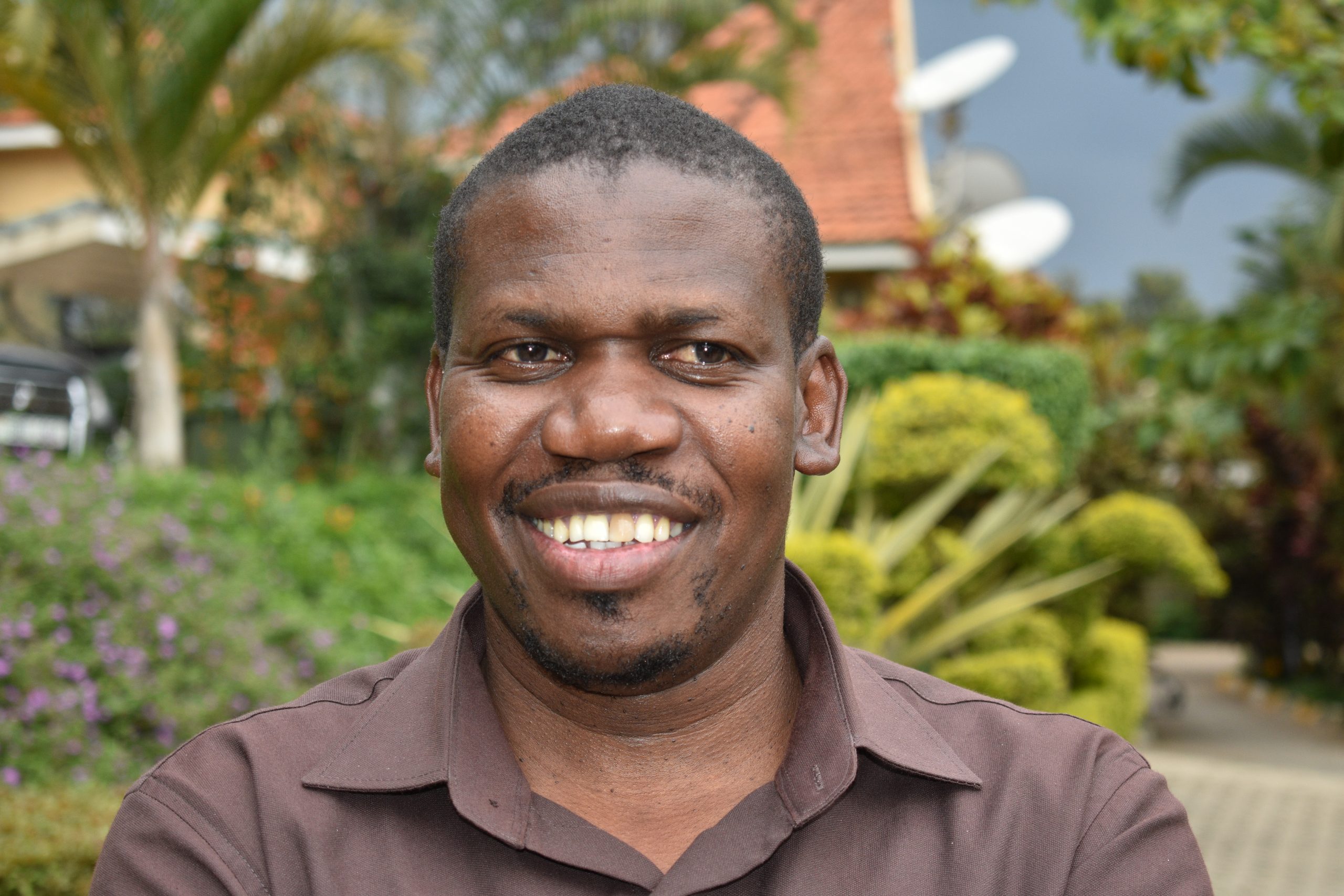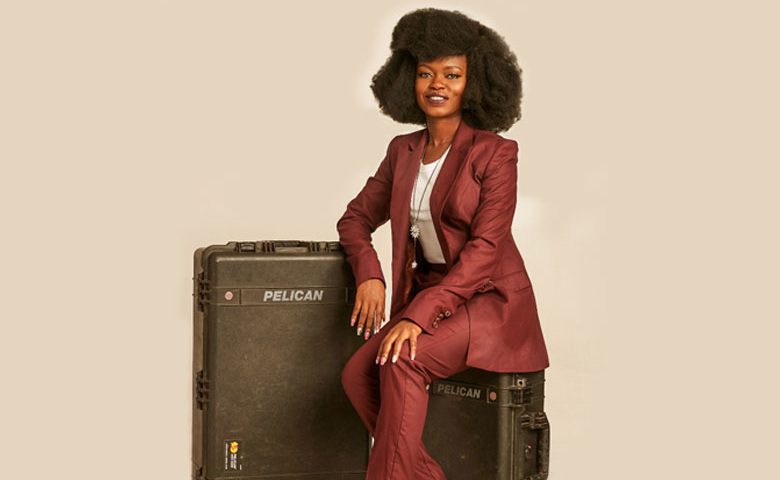There are unfortunate times during wars, conflict and terror attacks when human beings have been known to forget that which makes them human in a moment of insanity. The result is often disastrous with lasting negative impacts on society that often take years to heal and restore. However, there has always been that one person who is passionately driven in ensuring that healing and restoration is achieved no matter how long it takes. Such humane acts from selfless individuals, some who may have been directly impacted by these horrific disturbances is what always reminds us that human beings are not entirely devoid of empathy.
Ugandan human rights activist, Patrick Otim is proof of this. To understand better what he has been engaged in for over a decade in offering the much needed support to refugees and displaced persons in Uganda, I got in touch with him. In this exclusive interview, Patrick discusses his work at length, how the covid-19 pandemic has impacted him and what he plans to do once the normalcy we all crave resumes.
Welcome to ABOC Directory’s COVID-19 African Stories Series! It’s such a pleasure to have you and our readers would like to know more about you. Who is Patrick Otim?
I am a Pan-African filmmaker passionate about telling digital stories of migration and displacement but also documenting social change among conflict-affected communities in Uganda. I am currently working as a Video Advocacy Manager with the Refugee Law Project (RLP) where I have spent the last 13 years actively engaged in knowledge production and dissemination on forced migrants [Internally Displaced Persons (IDPs) & Refugees] related issues.
My youthful days have been a struggle surviving under forced encampment while also carrying out data collection research work in high-risk territories at the peak of the armed-conflict insurgency of northern Uganda (1996-2006). It’s this period that I point to my humanity and attribute to drawing my inspiration for sharing lived experiences to young people while advocating for their cause. That makes me a human rights activist.
As a trainer and mentor in filmmaking, I have (and continue to) skill over 107 refugees and host youth from northern Uganda in video advocacy, but also network with like-minded individuals and (regional) organizations that have since joined in collaborative efforts towards pushing for global good through video advocacy. A case to mention is the Video for change Network Africa where I am a member.
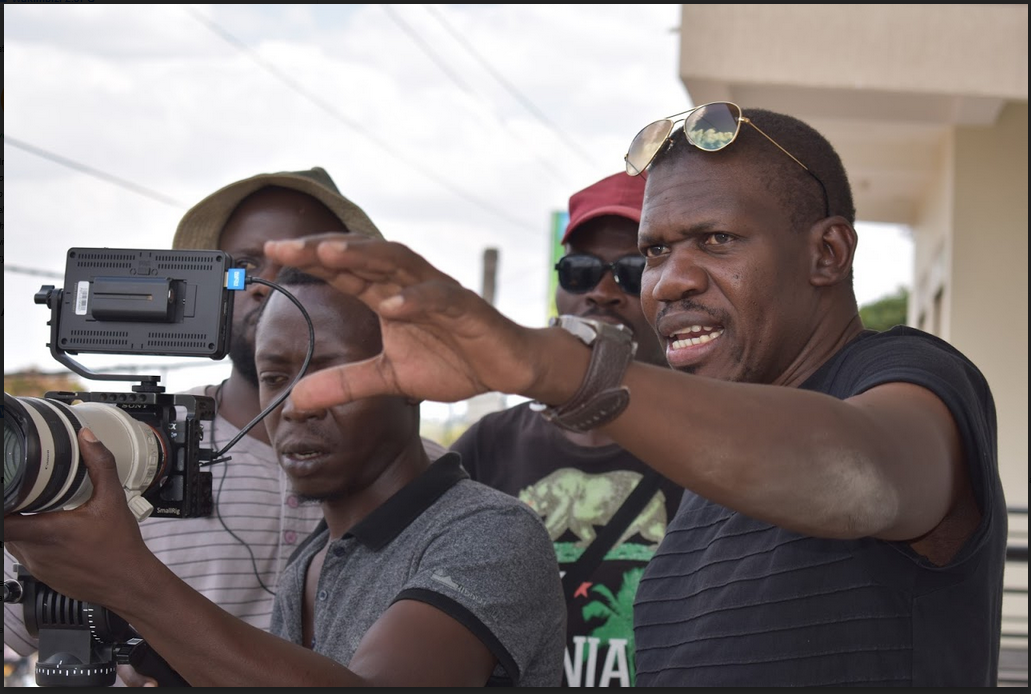
Photo by Patrick Otim
How would you describe the impact of your work?
To breakdown the impact of my work in our society, one needs to closely look at RLP’s Media for Social Change (M4SC) program, which is anchored around video advocacy strategy/model. Basically, this is the use of video/media-related tools and technologies to positively transform a community through a multi-level advocacy approach. Below is a summary of 3 major ones:
- VIDEO ADVOCACY
The early days of my work with marginalized communities during data collection involved the use of audio-visual recording, which was integrated into research during data collection as a methodology that would have an evidence-based integrity. These exercises were carried out with the interest of ensuring that the results would benefit the community in terms of interventions.
During dissemination of such research findings, it was realized that the use of the video clips became much more interactive and appealing to target audiences as opposed to written reports. This tool was able to paint a “human face” onto a scientific phenomenon through the videos screened to different audiences during a report launch.
As this method of dissemination became more popular within communities at validation periods, it became apparent that this activity was more important, meaningful and powerful in terms of the impact onto these communities. It was a game-changer in the lives of these vulnerable communities in many ways as detailed below through 2 impacts:
Social Therapy
This term is coined from an RLP experience of using video as a tool for healing a community recovering from an aftermath of war. For the first time, video was used in a public screening validating and acknowledging that male rape took place in the 2-decades-war in northern Uganda of 1986-2006.
Considered (then) a taboo in many African societies that a man can be raped, the revelation in the video, ‘They Slept with Me‘, was able to open an entire community to a collective acceptance of their reality which many of its members were silent about and undergoing emotional pain of their own. All of them except for the character in the video had never been able to open up. The character’s story testifying his ordeal to sexual violence prompted a big discussion that allowed so many other hidden victims and survivors to come out publicly and speak. This act (sexual violence) did not discriminate any gender but the remarkable inclusion of the male narrative to this discourse was ground breaking with many acknowledging the film lifted a heavy burden off their community.
One key outcome from the ‘social therapy’ is the continuous formation of survivor groups of sexual violence that today are used to offer psychosocial support and peer-to-peer counseling to their members as victims/survivors. This breakthrough is a beginning of a long journey to healing for the victims and the entire community. The confidence to openly talk about personal stories, documenting on video and screening personal experiences publicly, have offered vital feedbacks used to further support such communities and advocate globally through other documentaries such as ‘Gender Against Men’.
Video Letters
The use of videos as a conflict resolution tool has been tested within RLP with the outcome looking very promising. This methodology has been used to bring 2 conflicting clans accusing and counter-accusing each other of leading massacres towards their own clan members at the time of the Lord Resistance Army (LRA) insurgency in northern Uganda.
With one clan forced to flee from their ancestral land to a nearby district (about 120km away), the process required filming the accusation on camera and using it to brokering the peace talks between them through video screening. Responses among the 2 conflicting parties were carried back and forth and screened before them and those living far apart. This would then follow discussions surrounding the grievances before traveling to engage the other party on the responses. This back and forth movements and facilitations has today enabled the two clans begin to have face-to-face discussions among their representatives.
My youthful days have been a struggle surviving under forced encampment while also carrying out data collection research work in high-risk territories at the peak of the armed-conflict insurgency of northern Uganda (1996-2006). It’s this period that I point to my humanity and attribute to drawing my inspiration for sharing lived experiences to young people while advocating for their cause. That makes me a human rights activist.
2. TRAINING AND FILMMAKING SKILLS
With over a decade of audio-visual documentation of narratives and testimonies within IDP camps and refugees settlements, it was prudent to think about the sustainability of this impactful initiative of using video advocacy. It thus became decisive to start skilling the youth in these communities with filmmaking skills to take over the role of using the same tools to advocate for their own issues and rights other than ourselves.
Equipped with a 2-weeks boot-camp training model in filmmaking, a total of 6 boot camps were successfully conducted in 2019 and each hosting between 15-16 beneficiaries and benefitting an overall total number of 107. These included both male and female in the spirit of promoting gender equality. These youth have since gone ahead to use these skills in various enterprises and to win awards for their work and art. Many are able to present themselves and have got jobs as a result of these trainings.
As part of an outlet for the newly acquired skills, an initiative through which their talent can be appreciated was launched. This is the Wakimbizi Film Festival with an idea to have these youth use the platform to further engage high level authorities to instantly answer and handle issues affecting their communities. The initiative has also encouraged the youth to produce several films and videos relating to their plights and issues, which has since worked as a mentorship opportunity and further engagement in filmmaking as they polish their video advocacy skills.
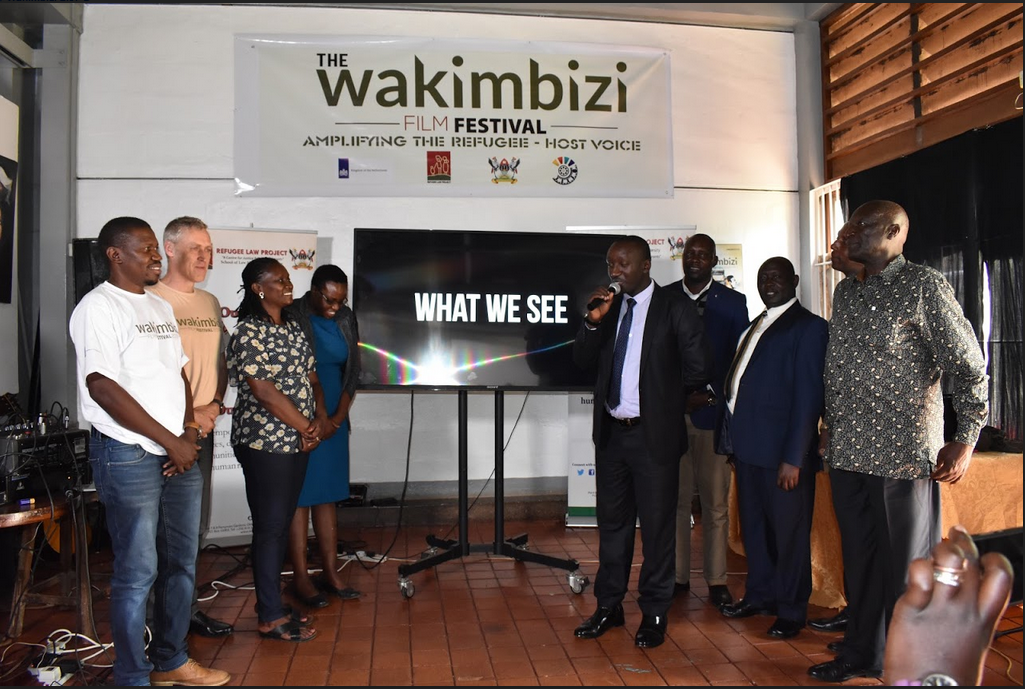
Photo by Patrick Otim
3. FACILITATED FILM SCREENING
In as much as there were several platforms through which videos and films were disseminated to different audiences for advocacy purposes, engaging the very community that were part of the production was not something that was considered as a methodology. In ensuring that media is effectively used to create social change, there is no better way than making sure the films are returned to the very community and screened for validation.
Facilitated film screening has been an addition to film screening where a moderate is able to paint a background to the issue in the film before screening and moderating a rigorous discussion. Here, the community members get the opportunity to debate and comment on the issue as they present a list of recommendations. The process is a great data generator in an organic setting that helps in identifying areas for intervention. This last stage completes the media for social change circle as it prompts for new issues coming from the audiences.
Social therapy is a term coined from a Refugee Law Project (RLP) experience of using video as a tool for healing a community recovering from an aftermath of war. For the first time, video was used in a public screening validating and acknowledging that male rape took place in the 2-decades-war in northern Uganda of 1986-2006.
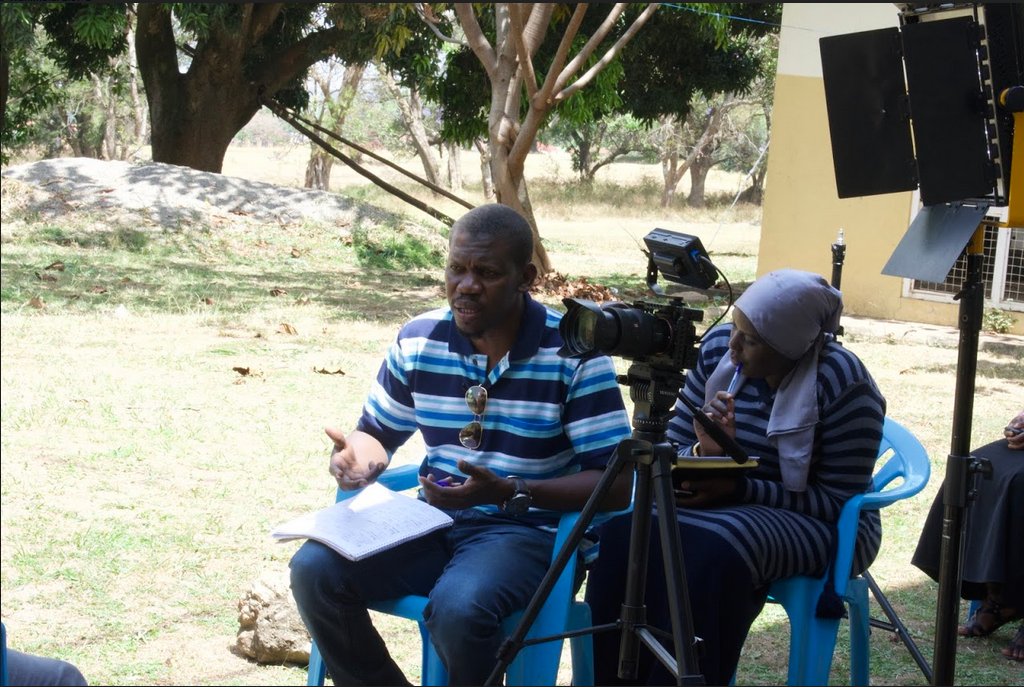
Photo by Patrick Otim
Before the COVID-19 Pandemic, how was your normal schedule like?
The nature of my work gives me the opportunity to travel across the country in various refugee settlements, where I engage in development of audio-visual content such as documentaries/films but I also engage in carrying out training in filmmaking, where I partake in imparting practical knowledge and skills to young refugees and host youth from refugee settlements.
That said, my normal schedule before the COVID-19 pandemic is a mix of both office work where I am preoccupied doing video editing, and fieldwork while shooting videos or conducting filmmaking training. So basically my work is quite adventurous since I get to travel a lot and meet so many people of different shades with whom I get to interact on a personal basis.
How has the COVID-19 Pandemic altered your schedule?
The COVID-19 is a global challenge that has put on hold all our operations and activities irrespective of which part of the world one is. When the lockdown was announced in Uganda, I was in the middle of a 2-week boot camp training in the northern city of Gulu. I became one of the first people to be arrested for “defying” the presidential directive of holding a meeting exceeding more than 10 individuals and I must say 24 days on, that experience is still vivid in my memory.
Trying to comprehend the impact of the shutdown to our planned schedule, work and livelihood tends to leave me shocked about the unknown. And specifically with the uncertainty that comes with working from home during lockdown while not knowing what tomorrow holds as many continue to perish from this pandemic in their hundreds. Also the fact of knowing the number is steadily rising in Africa, honestly leaves me very uncertain about what my routine is any more.
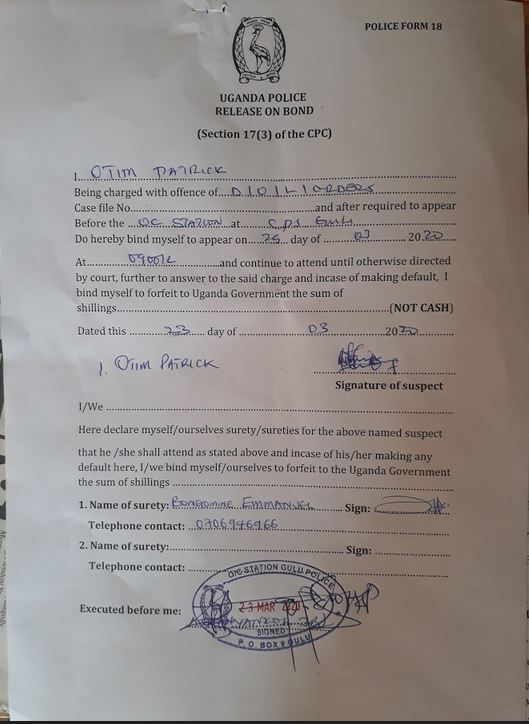
The Uganda Police Release on Bond Form for Patrick Otim after his arrest
What are you doing to ensure you remain motivated at this time? Have you devised a different way of doing things as you adhere to the lockdown in Uganda and social distancing?
To remain motivated in the midst of this global crisis, one needs to be positive. I have made it a habit to ensure that I re-invent a new routine of exercising every evening for 2 hours. This has helped relieve boredom and fatigue resulting from the “#Stayhome; #Staysafe” guideline. I have also used this period of lockdown to read a number of media-related materials regarding new innovations so as to be able to repackage our content once normalcy resumes. This includes learning Doodly, a new software that will be refreshing for our online audiences when we resume active engagement.
As part of coping with the reality, we have started virtual meetings where we connect with fellow staff using Zoom calls to strategize going forward in the event the crisis doesn’t go away any time soon.
However, what has not changed is the continued engagement on different WhatsApp groups with clients and staff. This has become much more active as more members use it to share vital information and news regarding the COVID19 guidelines and development.
To remain motivated in the midst of this global crisis, one needs to be positive. I have made it a habit to ensure that I re-invent a new routine of exercising every evening for 2 hours. This has helped relieve boredom and fatigue resulting from the “#Stayhome; #Staysafe” guideline. I have also used this period of lockdown to read a number of media-related materials regarding new innovations so as to be able to repackage our content once normalcy resumes. This includes learning Doodly, a new software that will be refreshing for our online audiences when we resume active engagement
What plans have you post COVID-19?
Post COVID-19, I plan to continue training 45 refugees and host youth in filmmaking skills scheduled for the year, bearing in mind the social distancing and adhering to other World Health Organization (WHO) guidelines for fighting coronavirus such as regular hand-washing and compulsory wearing of face masks.
My core work will be ensuring the production of a minimum of 2 documentaries on issues surrounding children born of rape and support groups as part of our advocacy strategy and also, re-packaging of media messages using Doodle in all refugee languages to re-echo safety guidelines ensuring effective dissemination of information.
To keep up with Patrick Otim’s work or get in touch, follow him on Twitter.



